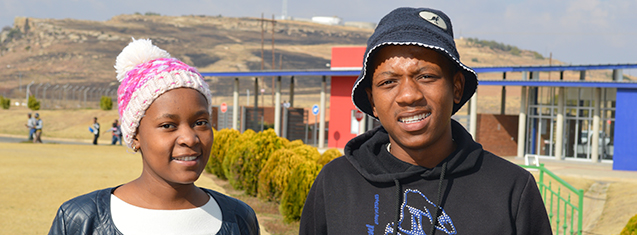
Matshediso Mokoena and Thato Monkoe.
Photo: Thabo Kessah
When Thato Monkoe and Matshediso Mokoena sat for their final matric examinations in 2014, all they had on their minds was not just passing, but passing well. Little did they know at that time that passing well would place so much responsibility on their shoulders.
Both Thato and Matshediso come from rural and disadvantaged backgrounds. They are first-year students at the Qwaqwa Campus of the University of the Free State, and are the first in their respective families to study at a university.
Thato describes his situation as “sad and good at the same time”.
“It is good, because I am the first one at home to have completed my matric and to have gone on to study at a tertiary institution. At the same time, it is sad as I feel sorry for my siblings who, for various reasons, did not have similar opportunities when they opted out of school”, said Thato, a BEd student.
”Now my sister and brother, as well as the entire family, perceive me as the one with brains, and this makes me uncomfortable. However, I am up for the challenge to be the first one to graduate with a degree in my family”.
Matshediso Mokoena, a BSc student, who obtained distinctions in Mathematics, Physical Sciences, and Life Sciences last year, concurs with Thato.
”As much as my family is supportive, there is always pressure as they expect the best from me,” she said.
“The pressure does not only come from my family. My entire community looks up to me, and they can’t stop talking about my achievements”, Matshediso revealed.
Both Thato and Matshediso are, however, happy that the dark cloud of doubt about academic achievement in their families has finally disappeared.
“At least someone in my family is hard at work carving her future, and willing to set a good example. That person is me”, said Matshediso, who aspires to be a medical doctor, and has a younger sister in Grade 8.
Thato and Matshediso are just two of hundreds of students making good use of the University of the Free State’s commitment to attract excellent and diverse students at both undergraduate and postgraduate levels, as reflected in the Strategic Plan 2015-2020.